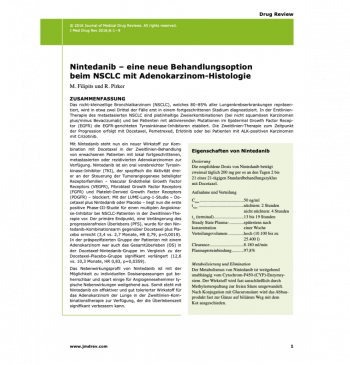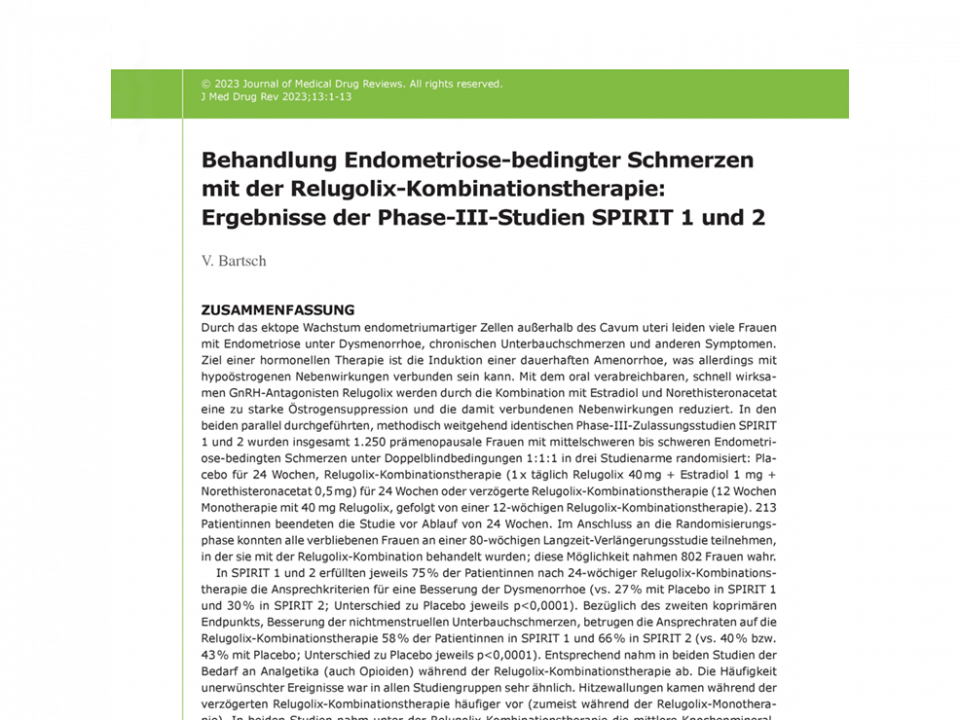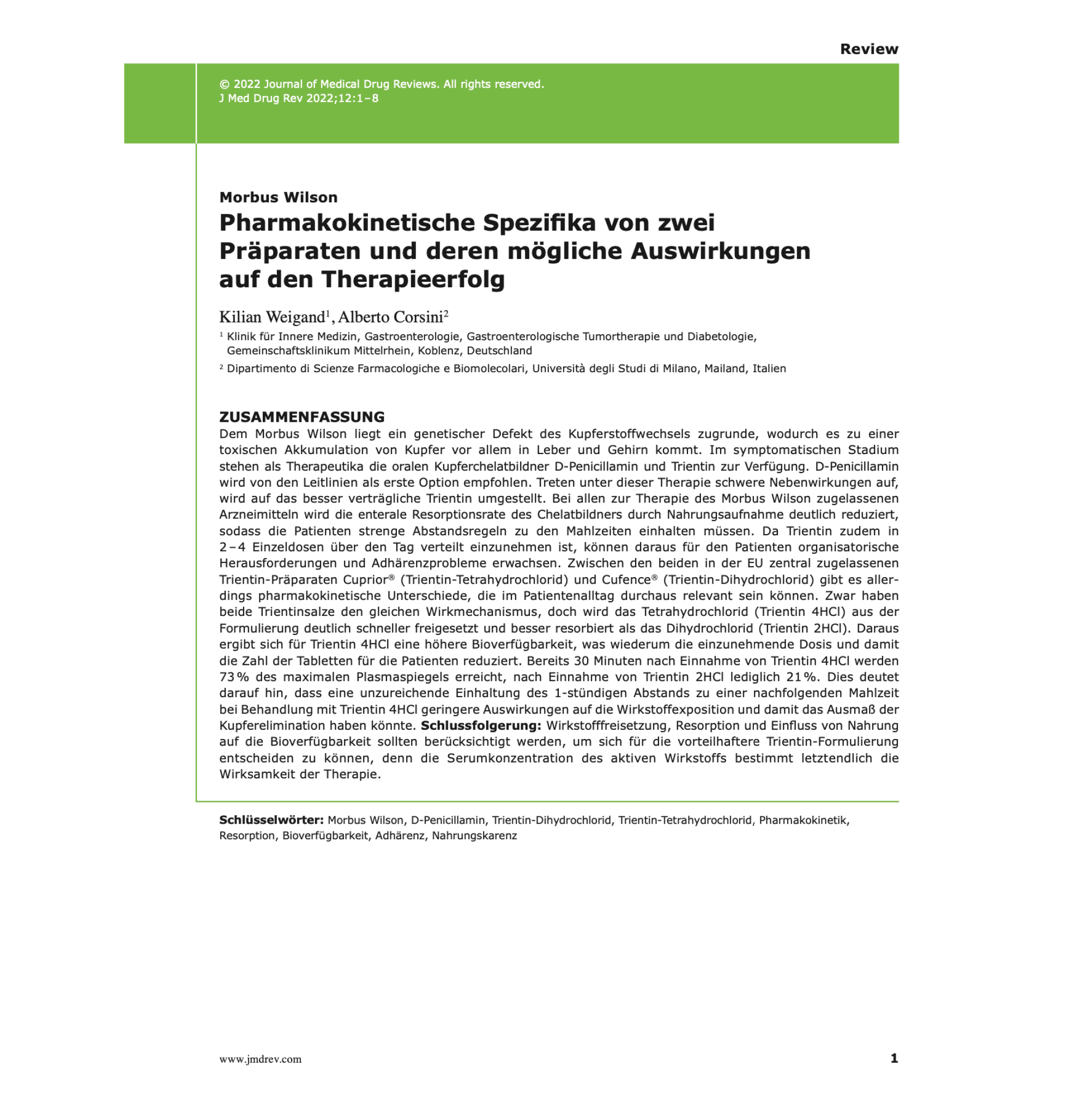Nintedanib – eine neue Behandlungsoption beim NSCLC mit Adenokarzinom-Histologie
J Med Drug Rev 2016;6:1-9
Das nicht-kleinzellige Bronchialkarzinom (NSCLC), welches 80–85% aller Lungenkrebserkrankungen repräsentiert, wird in etwa zwei Drittel der Fälle erst in einem fortgeschrittenen Stadium diagnostiziert. In der Erstlinien-Therapie des metastasierten NSCLC sind platinhaltige Zweierkombinationen (bei nicht squamösen Karzinomen plus/minus Bevacizumab) und bei Patienten mit aktivierenden Mutationen im Epidermal Growth Factor Receptor (EGFR) die EGFR-gerichteten Tyrosinkinase-Inhibitoren etabliert. Die Zweitlinien-Therapie zum Zeitpunkt der Progression erfolgt mit Docetaxel, Pemetrexed, Erlotinib oder bei Patienten mit ALK-positiven Karzinomen mit Crizotinib.
Mit Nintedanib steht nun ein neuer Wirkstoff zur Kombination mit Docetaxel in der Zweitlinien-Behandlung von erwachsenen Patienten mit lokal fortgeschrittenen, metastasierten oder rezidivierten Adenokarzinomen zur Verfügung. Nintedanib ist ein oral verabreichter Tyrosinkinase-Inhibitor (TKI), der spezifisch die Aktivität dreier an der Steuerung der Tumorangiogenese beteiligter Rezeptorfamilien – Vascular Endothelial Growth Factor Receptors (VEGFR), Fibroblast Growth Factor Receptors (FGFR) und Platelet-Derived Growth Factor Receptors (PDGFR) – blockiert. Mit der LUME-Lung-1-Studie – Docetaxel plus Nintedanib oder Placebo – liegt nun die erste positive Phase-III-Studie für einen multiplen Angiokinase-Inhibitor bei NSCLC-Patienten in der Zweitlinien-Therapie vor. Der primäre Endpunkt, eine Verlängerung des progressionsfreien Überlebens (PFS), wurde für den Nintedanib-Kombinationsarm gegenüber Docetaxel plus Placebo erreicht (3,4 vs. 2,7 Monate, HR 0,79, p=0,0019). In der präspezifizierten Gruppe der Patienten mit einem Adenokarzinom war auch das Gesamtüberleben (OS) in der Docetaxel-Nintedanib-Gruppe im Vergleich zu der Docetaxel-Placebo-Gruppe signifikant verlängert (12,6 vs. 10,3 Monate, HR 0,83, p=0,0359).
Das Nebenwirkungsprofil von Nintedanib ist mit der Möglichkeit zu individuellen Dosisanpassungen gut beherrschbar und spart einige für Angiogenesehemmer typische Nebenwirkungen weitgehend aus. Somit steht mit Nintedanib ein effektiver und gut tolerierter Wirkstoff für das Adenokarzinom der Lunge in der Zweitlinien-Kombinationstherapie zur Verfügung, der die Überlebenszeit signifikant verbessern kann.
Nintedanib – a new treatment option in NSCLC of adenocarcinoma tumour histology
Non-small cell lung cancer (NSCLC) accounts for 80-85% of all lung cancer cases. Approximately two thirds of patients are diagnosed with advanced-stage disease. In metastatic NSCLC, platinum-based double-agent regimes are the established first-line treatment (in non-squamous NSCLC plus/minus bevacizumab). Patients with activating mutations of the epidermal growth factor receptor (EGFR) are treated with anti-EGFR tyrosine kinase inhibitors in the first-line setting. Second-line treatment at the time of progression is with docetaxel, pemetrexed, erlotinib or with crizotinib in patients with ALK-positive NSCLC.
With nintedanib, a new compound is now available for combination therapy with docetaxel as second-line treatment for adult patients with locally advanced, metastatic or relapsed lung adenocarcinoma. Nintedanib is an oral tyrosine kinase inhibitor (TKI) that specifically targets and inhibits three receptor families controlling tumour-associated angiogenesis – the vascular endothelial growth factor receptor (VEGFR), the fibroblast growth factor receptor (FGFR) and the platelet-derived growth factor receptor (PDGFR) families. The LUME-Lung 1 study was the first positive phase III trial assessing the efficacy and safety of a multiple angiokinase inhibitor in the second-line treatment of patients with NSCLC. In this trial, patients were randomly assigned to receive either docetaxel plus nintedanib or docetaxel plus placebo. Progression-free survival (PFS) was significantly improved in the docetaxel plus nintedanib group compared with the docetaxel plus placebo group (3,4 vs. 2,7 months, HR 0,79, p=0,0019). Thus, the primary endpoint was met. In the prespecified subgroup of patients with adenocarcinoma histology, overall survival (OS), too, was significantly improved in the group treated with docetaxel plus nintedanib compared with the group receiving docetaxel plus placebo (12,6 vs. 10,3 months, HR 0,83, p=0,0359). Given the possibility of individualized dose adjustments, the adverse event profile of nintedanib is manageable and some adverse reactions, which typically emerge under treatment with angiogenesis inhibitors, are, for the most part, not expected to occur when treating patients with nintedanib. In conclusion, nintedanib is an effective and well-tolerated compound for second-line combination therapy in patients with lung adenocarcinoma, which may significantly improve survival.
Das nicht-kleinzellige Bronchialkarzinom (NSCLC), welches 80–85% aller Lungenkrebserkrankungen repräsentiert, wird in etwa zwei Drittel der Fälle erst in einem fortgeschrittenen Stadium diagnostiziert. In der Erstlinien-Therapie des metastasierten NSCLC sind platinhaltige Zweierkombinationen (bei nicht squamösen Karzinomen plus/minus Bevacizumab) und bei Patienten mit aktivierenden Mutationen im Epidermal Growth Factor Receptor (EGFR) die EGFR-gerichteten Tyrosinkinase-Inhibitoren etabliert. Die Zweitlinien-Therapie zum Zeitpunkt der Progression erfolgt mit Docetaxel, Pemetrexed, Erlotinib oder bei Patienten mit ALK-positiven Karzinomen mit Crizotinib.
Mit Nintedanib steht nun ein neuer Wirkstoff zur Kombination mit Docetaxel in der Zweitlinien-Behandlung von erwachsenen Patienten mit lokal fortgeschrittenen, metastasierten oder rezidivierten Adenokarzinomen zur Verfügung. Nintedanib ist ein oral verabreichter Tyrosinkinase-Inhibitor (TKI), der spezifisch die Aktivität dreier an der Steuerung der Tumorangiogenese beteiligter Rezeptorfamilien – Vascular Endothelial Growth Factor Receptors (VEGFR), Fibroblast Growth Factor Receptors (FGFR) und Platelet-Derived Growth Factor Receptors (PDGFR) – blockiert. Mit der LUME-Lung-1-Studie – Docetaxel plus Nintedanib oder Placebo – liegt nun die erste positive Phase-III-Studie für einen multiplen Angiokinase-Inhibitor bei NSCLC-Patienten in der Zweitlinien-Therapie vor. Der primäre Endpunkt, eine Verlängerung des progressionsfreien Überlebens (PFS), wurde für den Nintedanib-Kombinationsarm gegenüber Docetaxel plus Placebo erreicht (3,4 vs. 2,7 Monate, HR 0,79, p=0,0019). In der präspezifizierten Gruppe der Patienten mit einem Adenokarzinom war auch das Gesamtüberleben (OS) in der Docetaxel-Nintedanib-Gruppe im Vergleich zu der Docetaxel-Placebo-Gruppe signifikant verlängert (12,6 vs. 10,3 Monate, HR 0,83, p=0,0359).
Das Nebenwirkungsprofil von Nintedanib ist mit der Möglichkeit zu individuellen Dosisanpassungen gut beherrschbar und spart einige für Angiogenesehemmer typische Nebenwirkungen weitgehend aus. Somit steht mit Nintedanib ein effektiver und gut tolerierter Wirkstoff für das Adenokarzinom der Lunge in der Zweitlinien-Kombinationstherapie zur Verfügung, der die Überlebenszeit signifikant verbessern kann.
Nintedanib – a new treatment option in NSCLC of adenocarcinoma tumour histology
Non-small cell lung cancer (NSCLC) accounts for 80-85% of all lung cancer cases. Approximately two thirds of patients are diagnosed with advanced-stage disease. In metastatic NSCLC, platinum-based double-agent regimes are the established first-line treatment (in non-squamous NSCLC plus/minus bevacizumab). Patients with activating mutations of the epidermal growth factor receptor (EGFR) are treated with anti-EGFR tyrosine kinase inhibitors in the first-line setting. Second-line treatment at the time of progression is with docetaxel, pemetrexed, erlotinib or with crizotinib in patients with ALK-positive NSCLC.
With nintedanib, a new compound is now available for combination therapy with docetaxel as second-line treatment for adult patients with locally advanced, metastatic or relapsed lung adenocarcinoma. Nintedanib is an oral tyrosine kinase inhibitor (TKI) that specifically targets and inhibits three receptor families controlling tumour-associated angiogenesis – the vascular endothelial growth factor receptor (VEGFR), the fibroblast growth factor receptor (FGFR) and the platelet-derived growth factor receptor (PDGFR) families. The LUME-Lung 1 study was the first positive phase III trial assessing the efficacy and safety of a multiple angiokinase inhibitor in the second-line treatment of patients with NSCLC. In this trial, patients were randomly assigned to receive either docetaxel plus nintedanib or docetaxel plus placebo. Progression-free survival (PFS) was significantly improved in the docetaxel plus nintedanib group compared with the docetaxel plus placebo group (3,4 vs. 2,7 months, HR 0,79, p=0,0019). Thus, the primary endpoint was met. In the prespecified subgroup of patients with adenocarcinoma histology, overall survival (OS), too, was significantly improved in the group treated with docetaxel plus nintedanib compared with the group receiving docetaxel plus placebo (12,6 vs. 10,3 months, HR 0,83, p=0,0359). Given the possibility of individualized dose adjustments, the adverse event profile of nintedanib is manageable and some adverse reactions, which typically emerge under treatment with angiogenesis inhibitors, are, for the most part, not expected to occur when treating patients with nintedanib. In conclusion, nintedanib is an effective and well-tolerated compound for second-line combination therapy in patients with lung adenocarcinoma, which may significantly improve survival.




